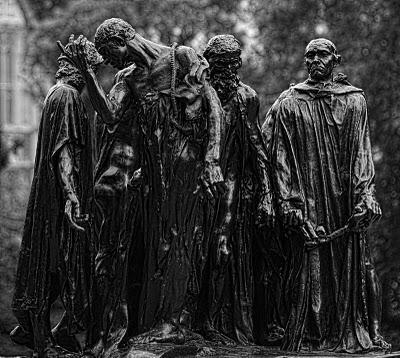This post first appeared in November 2010 Up-close with one of the great works of art in London (Read Part One HERE).David examines Rodin’s The Burghers of Calais…
Up-close with one of the great works of art in London (Read Part One HERE).David examines Rodin’s The Burghers of Calais…
Think of the heroine of the Burghers of Calais tale, Philippa. She would lose two of her 14 children to the Black Death. At Calais Philippa was heavily pregnant with her tenth child and she interceded because she thought killing the burghers would be bad karma for her unborn child.
That was what was ahead for these people. What was behind was that just a month previously the burghers, with the English looking on, had watched 500 of their children and their old starve to death just outside the city walls. They’d expelled them from the city so that the final reserves of food could go to the remaining healthy men and women. The English wouldn’t let the children and the oldsters approach their siege lines, let alone give them a free pass through. They starved to death beneath the walls of Calais. Under the eyes of besieger and besieged.
But given what was two months in the future for one and all, that was a mercy.
And the immediate future – the next ten minutes – for these six men? King Edward was furious that Calais had dared to resist him. He thought he was King of France, after all. And in any case Calais had been a hotbed of piracy in the past – its ships had preyed on English commerce. In short, “exemplary punishment”, as it was known – genocide we’d be tempted to call it today – was on the cards.
The king’s advisers – including, incidentally, Sir Walter de Manny, he of Charterhouse fame – counseled against mass murder. Edward compromised. He said, “all right I want their six richest citizens. I want them to walk out of that place in their shirts, their feet bare, with the keys of the city, and ropes round their necks. “
Which of course is precisely what Rodin shows us in the sculpture. The ropes, incidentally, signified the victor’s right to hang them at will.
Edward said, “on them I shall work my will. The rest I will receive to my mercy.”
At which point Philippa’s unborn child kicked in the womb.
Three final points.
1) Edward said to Philippa, “Ok, they’re yours. Deal with them as you please. That meant their property was hers as well as their bodies. One of the six was John Daire, the richest man in Calais.
Philippa saved his life but she helped herself to his houses.
2) It’s not just the Rodin sculpture that puts us in mind of those long ago times. The Prince of Wales’ feathers also waft us right back to the 1340s. (Watch this space!)
3) Calais was “English” until 1558. The recovery of Calais. The French had their cause; the Hundred Years War its lifeline.
Ask David all about it in person this Thursday on the Old Westminster Walk.

